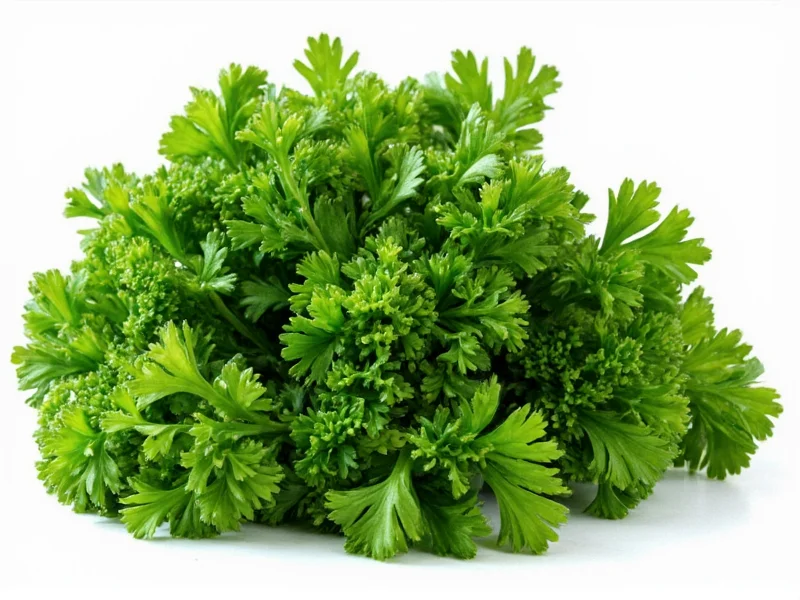When you're in the middle of cooking and realize you're out of parsley, knowing reliable alternatives can save your dish. This guide provides practical, chef-tested parsley substitutes that work in real kitchen scenarios—not just theoretical suggestions.
Understanding Parsley's Role in Cooking
Parsley isn't just a pretty garnish. This versatile herb contributes a mild, fresh, slightly peppery flavor that complements rather than dominates dishes. It contains subtle grassy notes with hints of citrus, making it valuable in both raw and cooked applications. When seeking what to substitute for parsley, consider whether you need it for flavor, color, texture, or all three.
Top Parsley Substitutes by Culinary Application
Not all parsley replacements work equally well in every situation. The best alternative depends on your specific cooking context:
Best Substitutes for Garnishing
When appearance matters most, such as finishing a soup or plating a main course:
- Cilantro: Offers similar visual appeal with a brighter, more citrusy flavor. Use in equal amounts. Best for Mexican, Asian, and Latin American dishes.
- Chives: Provide attractive green color with a mild onion flavor. Chop finely and use about 25% less than the parsley amount called for.
- Green onions (scallions): The green parts make an excellent visual substitute. Use the same quantity as parsley.
Best Substitutes for Cooking Applications
When parsley will be cooked into the dish:
- Dill: Works particularly well in fish dishes, potatoes, and egg salads. Use slightly less dill than parsley as it has a stronger flavor.
- Tarragon: Excellent in French cuisine and with chicken. Use about 75% of the parsley amount due to its more pronounced anise-like flavor.
- Celery leaves: Often overlooked but perfect for soups, stews, and stocks. Use equal amounts to parsley.
Best Dried Herb Alternatives
When fresh herbs aren't available:
- Dried parsley: The most direct substitute, though less vibrant. Remember the 1:3 ratio (1 teaspoon dried = 1 tablespoon fresh).
- Dried basil: Provides similar earthiness. Use half the amount of dried basil compared to fresh parsley.
- Italian seasoning blend: Contains parsley plus complementary herbs. Use sparingly as it's a stronger mix.
| Substitute | Flavor Profile | Best For | Substitution Ratio |
|---|---|---|---|
| Cilantro | Bright, citrusy, slightly peppery | Salsas, guacamole, Asian dishes, garnishing | 1:1 (fresh) |
| Chives | Mild onion flavor, delicate texture | Garnishing, potato dishes, creamy sauces | 3:4 (use 25% less) |
| Dill | Grassy, slightly sweet, anise notes | Fish, cucumber salads, egg dishes | 3:4 (use 25% less) |
| Tarragon | Sweet, anise-like, slightly peppery | Chicken, French cuisine, vinegar-based dressings | 3:4 (use 25% less) |
| Celery leaves | Earthy, mild celery flavor | Soups, stews, stocks, braises | 1:1 (fresh) |
| Dried parsley | Muted herbal notes | Dry rubs, sauces, dishes requiring long cooking | 1:3 (1 tsp dried = 1 tbsp fresh) |
Cuisine-Specific Substitution Guidance
Understanding what to use instead of parsley varies by culinary tradition:
Mediterranean Dishes
For Greek salads, Italian pasta dishes, or Spanish preparations, fresh basil makes an excellent parsley substitute. Its sweet, slightly peppery profile complements tomatoes and olive oil beautifully. Use equal amounts of fresh basil as you would parsley.
Mexican and Latin American Cuisine
Cilantro is actually more traditional than parsley in these cuisines. When wondering what can replace parsley in salsa or guacamole, cilantro is the natural choice. Use the same quantity as parsley would require.
French Cooking
For French recipes calling for parsley, tarragon provides the most authentic flavor profile. This classic herb pairing works particularly well in béarnaise sauce, chicken dishes, and vegetable preparations. Use slightly less tarragon than the parsley amount specified.
Common Substitution Mistakes to Avoid
When searching for what to substitute for fresh parsley, avoid these common pitfalls:
- Using too much stronger herbs: Oregano, rosemary, or thyme have much more intense flavors. These work poorly as direct parsley replacements.
- Ignoring texture differences: Some substitutes like dill have more delicate stems that cook faster than parsley.
- Substituting dried for fresh without adjusting quantities: Dried herbs are more concentrated—always use less.
- Using bitter greens as substitutes: Arugula or mustard greens have completely different flavor profiles that won't work in most parsley applications.
Creating Your Own Herb Mixtures
When you need what herb can replace parsley in a pinch, consider making a custom blend:
- For general cooking: Mix equal parts dried basil, dried chives, and dried parsley (if available)
- For Mediterranean dishes: Combine dried oregano, dried marjoram, and a touch of dried mint
- For French cuisine: Blend dried tarragon, dried chervil, and dried parsley
Store these mixtures in airtight containers away from light and heat. Properly stored, they'll maintain flavor for 6-12 months—much longer than individual fresh herbs.
When No Substitute Will Do
Some dishes truly require parsley's unique qualities. If you're making tabbouleh, gremolata, or chimichurri, the specific flavor profile of parsley is essential. In these cases, consider adjusting your recipe rather than substituting, or plan ahead for your next grocery trip.
Practical Tips for Herb Management
To avoid future "what to substitute for parsley" emergencies:
- Freeze chopped parsley in olive oil in ice cube trays for ready-to-use portions
- Grow a small parsley plant on your windowsill for fresh supply
- When buying fresh herbs, divide the bunch and freeze half immediately
- Keep dried parsley in your spice collection as a reliable backup











 浙公网安备
33010002000092号
浙公网安备
33010002000092号 浙B2-20120091-4
浙B2-20120091-4